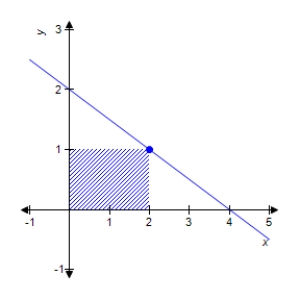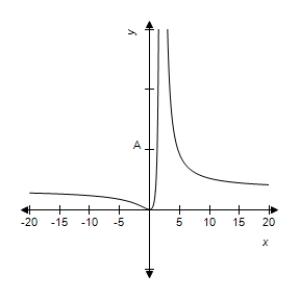A) ![]()
B) ![]()
C) ![]()
D) ![]()
E) ![]()
Correct Answer

verified
Correct Answer
verified
Multiple Choice
If the total revenue function for a blender is  ,determine how many units x must be sold to provide the maximum total revenue in dollars.
,determine how many units x must be sold to provide the maximum total revenue in dollars.
A) 625
B) 15,000
C) 25
D) 300
E) 50
Correct Answer

verified
Correct Answer
verified
Multiple Choice
Find the dimensions of the rectangle of maximum area bounded by the x-axis and y-axis and the graph of 

A) length 1.5; width 1.25
B) length 2; width 1
C) length 0.5; width 1.75
D) length 1; width 1.5
E) none of the above
Correct Answer

verified
Correct Answer
verified
Multiple Choice
When the price of a glass of lemonade at a lemonade stand was $1.75,400 glasses were sold.When the price was lowered to $1.50,500 glasses were sold.Assume that the demand function is linear and that the marginal and fixed costs are $0.10 and $ 25,respectively.Find the marginal profit when 300 glasses of lemonade are sold and when 700 glasses of lemonade are sold.
A) ![]() ,
, ![]()
B) ![]() ,
, ![]()
C) ![]() ,
, ![]()
D) ![]() ,
, ![]()
E) ![]() ,
, ![]()
Correct Answer

verified
Correct Answer
verified
Multiple Choice
Use the properties of logarithms to write the expression as a single logarithm. 
A) ![]()
B) ![]()
C) ![]()
D) ![]()
E) ![]()
Correct Answer

verified
Correct Answer
verified
Multiple Choice
Find the third derivative of the function 
A) ![]()
B) ![]()
C) ![]()
D) ![]()
E) ![]()
Correct Answer

verified
Correct Answer
verified
Multiple Choice
Sketch the graph of the function  ?
?
A) ![]()
B) ![]()
C) ![]()
D) ![]()
E) ![]()
Correct Answer

verified
Correct Answer
verified
Multiple Choice
A function and its graph are given.Use the graph to find the horizontal asymptotes,if they exist,where  Confirm your results analytically.
Confirm your results analytically.


A) ![]()
B) ![]()
C) ![]()
D) ![]()
E) no horizontal asymptotes
Correct Answer

verified
Correct Answer
verified
Multiple Choice
Analyze and sketch a graph of the function 
A) ![]()
B) ![]()
C) ![]()
D) ![]()
E) ![]()
Correct Answer

verified
Correct Answer
verified
Multiple Choice
Find  for the equation
for the equation  by implicit differentiation and evaluate the derivative at the point
by implicit differentiation and evaluate the derivative at the point 
A) ![]()
B) ![]()
C) ![]()
D) ![]()
E) 0
Correct Answer

verified
Correct Answer
verified
Multiple Choice
A survey of high school seniors from a certain school district who took the SAT has determined that the mean score on the mathematics portion was 450 with a standard deviation of 11.5.By a normal probability density function the data can be modeled as  Find the derivative of the model.
Find the derivative of the model.
A) ![]()
B) ![]()
C) ![]()
D) ![]()
E) ![]()
Correct Answer

verified
Correct Answer
verified
Multiple Choice
Write the equation of the line passing through the given pair of points. 


A) ![]()
B) ![]()
C) ![]()
D) ![]()
E) ![]()
Correct Answer

verified
Correct Answer
verified
Multiple Choice
For the given function,find the relative minima.

A) ![]()
B) ![]()
C) ![]()
D) ![]()
E) no relative minima
Correct Answer

verified
Correct Answer
verified
Multiple Choice
Find the x-values (if any) at which the function  is not continuous.Which of the discontinuities are removable?
is not continuous.Which of the discontinuities are removable?
A) no points of discontinuity
B) ![]() (not removable) ,
(not removable) , ![]() (removable)
(removable)
C) ![]() (removable) ,
(removable) , ![]() (not removable)
(not removable)
D) no points of continuity
E) ![]() (not removable) ,
(not removable) , ![]() (not removable)
(not removable)
Correct Answer

verified
Correct Answer
verified
Multiple Choice
Find the derivative of the following function. 
A) ![]()
B) ![]()
C) ![]()
D) ![]()
E) ![]()
Correct Answer

verified
Correct Answer
verified
Multiple Choice
Suppose that  and
and  Find the following limit:
Find the following limit: 
A) 13
B) 24
C) 2
D) -143
E) 11
Correct Answer

verified
Correct Answer
verified
Multiple Choice
Find all relative minima of the given function.

A) ![]()
B) ![]()
C) ![]()
D) ![]()
E) no relative maxima
Correct Answer

verified
Correct Answer
verified
Multiple Choice
Write the equation of the line through  that is perpendicular to
that is perpendicular to 
A) ![]()
B) ![]()
C) ![]()
D) ![]()
E) ![]()
Correct Answer

verified
Correct Answer
verified
Multiple Choice
What lump sum should be deposited in an account that will earn at an annual rate of 9%,compounded quarterly,to grow to $150,000 for retirement in 20 years? Round your answer to the nearest cent.
A) $147,330.10
B) $18,292.68
C) $53,571.43
D) $24,961.93
E) $25,294.49
Correct Answer

verified
Correct Answer
verified
Multiple Choice
Find  ,if
,if 
A) ![]()
B) ![]()
C) ![]()
D) ![]()
E) ![]()
Correct Answer

verified
Correct Answer
verified
Showing 161 - 180 of 427
Related Exams